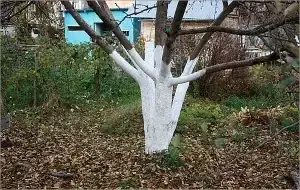TL;DR: I did not find any scientific consensus on this subject.
The claim:
According to this 2014 Statesmen article,
Horticulturists from the University of California and Sunset magazine still recommend this tried-and-true technique. This method still is used by professional orchardists.
It claims that the method "prevents sunburned tree bark" and "protects from damaging boring insects such as beetles, moth larvae and horntails", possibly by filling cracks in the bark.
For techniques, it mentions "an old-fashioned recipe" of "salt and hydrated lime for whitewash", "white latex paint", "wrapping the trunks with paper, plastic or cloth tape", and even "white corrugated drain pipe".
It seems that there are several ways of whitewashing trees without using CaO.
More authoritative sources:
The University of California Agricultural & Natural Resources Pest Management Program states this in regard to avocado trees and sunburn:
Whitewash young trees routinely at planting.
Moreover,
Special whitewash products are available, or white interior latex paint diluted 50% with water can be applied. An inexpensive whitewash formula is 50 lbs hydrated lime and 4 lbs zinc sulfate to each 100 gallons of water. Certain white film kaolin clay particle products can be sprayed onto foliage to reduce sunburn and tree heat stress...
The webpage sources a peer-reviewed publication. As far as I can tell, it does not mention potential risks during acid rain. It does mention "hydrated lime", which is Ca(OH)2, not CaO, which is soluble in acids.
CaO and acid rain:
Note that CaO, "quicklime", reacts to form Ca(OH)2, "hydrated lime", in water. Hydrated lime is soluble in acids.
Most importantly, liming can neutralize acidic water and buffer them from rapid fluctuations in pH. The source states that liming is advantageous due to being "non-toxic", a "natural mineral", and "dissolvable in water". It states these qualifications for the lime:
Use high-quality, contaminant-free (< 5% of magnesium), and nutrient-free (low nitrates and phosphates) agricultural lime.
However, it does not recommend hydrated lime, because
Hydrated lime (calcium hydroxide, Ca(OH)2) and quicklime (calcium oxide, Ca(OH)2)... are corrosive, difficult to control, and may not be legal to apply. Hydrated lime and quicklime have been used for acid neutralization because less is needed (they have higher neutralizing values than pure limestone), but both are caustic.
Causticity is a property of corrosive substances, which cause chemical burns on contact. (This may be the source of claims that it is a "good disinfectant" and "prevents insects".) However, since we have seen that there are various ways to prepare the whitewash mixture, it's possible that causticity is sufficiently low.
Moreover, according to this source,
Acid rain is more likely to weaken trees by damaging their leaves rather than killing them directly. By damaging their leaves, they trees cannot receive as many nutrients or make them more susceptible to toxic substances.
If this is the case, then it's possible that whitewashed trees die mostly due to acid rain, rather than a combination of acid rain and whitewash.
The conclusion:
There appears to be no scientific consensus on avoiding whitewash for trees.
